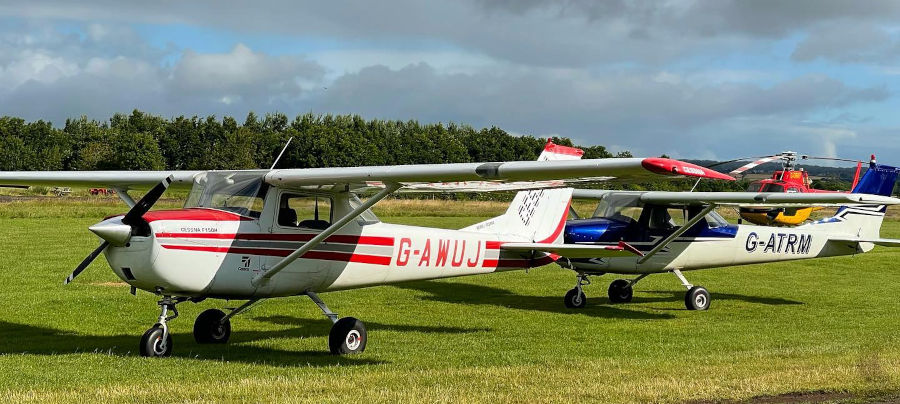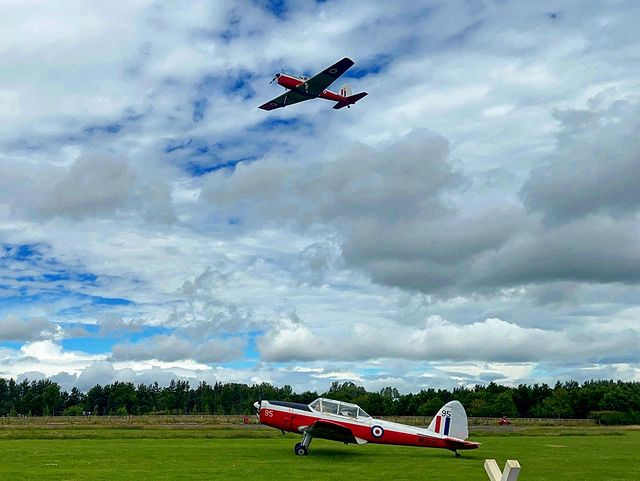
It’s been over a month since my last flying lesson, since the unfortunate accident involving the Reims-Cessna F150H (a Cessna 150 built under license in France), which I had only just started to grips with.
The flight school acquired another F150H, a 1968 model registration G-AWUJ, which had just been fitted with a brand new engine and propeller, and finished the refurbishment of the second 150 – a Reims-Cessna F150F from 1966.
External Checks
After the briefing I headed out to G-AWUJ. Feeling rusty, I picked up the checklist from the glove box and ran through the external checks with my instructor – lights working, landing gear in good condition and no cracks, wings attached, struts undamaged, control surfaces movable and all linkages connected, my instructor drained some fuel to check for contamination (which on this particular F150H requires an act of contortion to pull a lever in the engine bay and catch the fuel from a nozzle under the nose cowling) and dipped the oil before climbing into the cockpit and turning off all the electrical equipment I’d switched on to test (e.g. navigation and landing lights).
Internal Checks
Next came the internal checks, instruments, circuit breakers, throttle and mixture movement, carb heat, and flight controls. Finally it came time to start the engine. I primed the engine with a ‘squirt’ of fuel, pushed the mixture control (which controls the amount of fuel that is added to the air going into the engine) all the way in to its most rich (most fuel added) and turned the key to activate the magnetos and the starter motor and ….. the key turned without any friction. The ignition cylinder was completely loose!
We called one of the mechanics over to have a look – fortunately the airfield has a very active aero engineering centre on site – and the problem was rectified within a few minutes. This time when I turned the key it nipped at the expected magneto detents before activating the starter motor and the propeller began to spin.

Taxi
The airfield is uncontrolled, that means there’s no air traffic control (ATC) instructing aircraft on the ground and nearby in the air what to do to remain separated from each other. There is an AGCS (air-ground communication service) at the field but this is not guaranteed to be staffed. I transmitted a radio call alerting anyone on the frequency that we were starting to taxi and would be entering one of the runways (01/19) to proceed to the most appropriate – given the prevailing wind – runway (26).
I taxied to the start of runway 26 and entered the holding point (Delta) to perform our run up checks. Once they were done I lined up on the runway, put my heels on the floor (to prevent accidentally pressing the brakes on the take-off roll), pushed the throttle to full and locked my right foot forward slightly on the right rudder pedal to counter-act the left-yawing moment that results from applying full power on a single-engine propeller aircraft with a clockwise-rotating propeller (when viewed from the cockpit).
As the Cessna headed down the runway I called out “airspeed alive”, as soon as the air speed indicator (ASI) started to receive enough air into the pitot tube to register our airspeed, “Ts and Ps in the green”, which meant that I had looked at the oil temperature and pressure and everything was correctly within limits, and then finally, with a glance at the tachometer, “RPMs stable.”
The plane was in good shape, we just needed enough air flowing over the wings to become airborne.
“40 knots,” I said as a gust of wind hit the tail fin and pushed the nose to the left. I pushed harder on the right rudder pedal to keep us straight on the runway and out of the trees to the left of the end of runway 26. “50 knots.” That was our Vr speed – the speed to lift off.
Wind Shear
The little 150 climbed quickly but that crosswind became increasingly strong requiring more and more right rudder. Being a little rusty this was not done with finesse and more with brute force.
At 300ft, just as I was lifting the flap lever to raise the flaps we hit wind-shear from the trees – wind shear is caused by a change in direction of the wind. This can cause an aircraft to suddenly find more lift if the wind changes onto the nose of the aircraft, but – as in our case – if the wind shifts to behind the wings you can find yourself losing lift.
The nose didn’t move off the horizon but the aircraft suddenly dropped 10-20ft. My hand, which was on the flap lever moved up when the windshear hit us, which was fine, because I was trying to raise the flaps anyhow, but then when the windshear stopped and weight returned to our bodies and limbs, I had pushed the flap lever down causing it to begin extending further flap. This is a bad thing on departure because this added drag makes it impossible to climb. Thankfully, I knew what I’d done and rectified the situation as soon as it happened.
“Wind shear,” said my instructor, “at the worst possible moment. Nicely handled.”
Learning to Fly
The great thing about aviation is the strict no-blame culture. Everyone is learning (not just the student pilots!) and mistakes are made. The important thing is to accept this, allow for errors, but take a lesson from them. Flight instructors in particular need to be good at building confidence in students without building arrogance.
The International Civil Aviation Authority (ICAO) even states in its aptly numbered Annex 13 that air accident reports should
not be used to apportion blame or assign liability.
Annex 13, Appendix 2, Chapter 6
It even recommends that:
air accident personnel are not compelled to give opinions on matters of blame or liability in civil, criminal, administrative or disciplinary proceedings.
Annex 13, Appendix 2, Chapter 6
Instead states who are members of ICAO (which is most nations) should adhere to the following:
The sole objective of the investigation of an accident or incident shall be the prevention of accidents and incidents.
Annex 13, Chapter 3, Section 3.1
In the UK there is a confidential reporting system called CHIRP allowing confidential reports to be made for aviation and maritime incidents.
Thankfully, on this occasion, we didn’t need anything like this and the rest of the climb went without incident.
Climbing and Descending
On this lesson we continued climbing and descending, only this time we climbed and descended whilst turning. This might sound easy but when you’re trying to hit an altitude and nail a heading at the same time, while managing throttle, three axes of movement, avoiding cloud and avoiding exceeding bank limits for different regimes of flight (climbing and descending you should only bank a maximum of 30 degrees, known as a rate 2 turn, although a rate 1 turn is recommended because your stall speed increases when you roll the wings), it is quite complicated.
We did a few more climbs and descents but then we headed back to the airfield, flying overhead the historic market town of Alnwick, abeam the infamous “golfball” radar dome on the Cheviot hills overlooking the town, and followed the A1 major route south, keeping it on our left per the recommendations that any linear infrastructure used for navigation should be kept on your left!
Overhead Join
5-10 miles from the airfield I requested a change of frequency from Scottish Information to the airfield’s AGCS (air-ground communication service) frequency, and then let anyone on the airfield’s frequency that we were just South of Alnwick and we were going to be ‘joining overhead’, which meant we could get a good look at the windsock and any aircraft in the pattern to know which runway we should be using.
Over the airfield we saw the windsock was still pointing straight down runway 26 and I said to my instructor as much. “Let’s land on runway 19 instead, you’ve not landed on that yet.”
The pattern was empty because there was a big fly-in event at Leeds East airport so anyone with a pair of wings and an engine was headed there instead.
So I knew this would be a crosswind landing requiring us to ‘crab’ (pointing the nose into the wind to remain straight down the runway). Having not landed on runway 19 before, I needed to learn all the visual reference points to know where to turn for each leg of the pattern.
Furthermore, I’d not flown this particular Cessna 150 before and it had a few quirks, particularly with its rudder. My instructor knew this was going to be a challenge for me.
I descended to pattern altitude on the dead-side of runway 19 (flying straight over the clubhouse and cafe at the airfield) but extended our upwind leg due to noise abatement rules around the airfield. Noise abatement procedures minimise over-flight of noise-sensitive areas (posh houses, basically). This was actually very fortunate because as I turned onto crosswind, we got to watch one of the RAF Chipmunks based at the airfield take off from 19G (19 grass) which runs parallel to the tarmac runway 19, and turned right within the radius of our turn. This meant we got a full view of the Chippie climbing up and away much faster and nimbly than the Cessna.

Turning downwind, I ran through the BUMFILCH memory items: Brakes, Undercarriage, Mixture, Flaps and Fuel, Instruments, Landing Light, Carb Heat, Hatches and Harnesses. However, I didn’t get to complete it because the tailwind was so strong it was time to turn onto base and configure for landing.
Approach
Using the visual reference point of a bridge I then turned onto final, making sure to point the nose a few degrees to the right of the runway to compensate for the cross-wind.
I’d always struggled to understand how pilots know just how many degrees to the right or left to point their nose to remain straight towards the runway but after a few small adjustments to correct for the centreline ‘swinging’ left or right it was quite a natural and intuitive process, all done by ‘feel’.
So with the nose pointing to the right and the aircraft tracking straight down the extended centreline all looked good.
Remember those trees to the left of the end of runway 26 that caused that wind shear on take off? Those are to the right of the touch down zone on runway 19, so as I entered ground effect I also hit a gust of wind which blew me to the left (toward 19G!). I corrected quickly but bluntly with the rudder, and pulled back a little too hard in the flare, causing us to rise and the stall warning horn to squeak. I pushed the nose forward so I could see the runway again, flared for a second time and landed with a bit of a bump. I sighed, relieved that we were down safe, my heart was pounding.
“Full power,” said my instructor. “Go around”.
I pushed the throttle forward, locked my foot on the right rudder pedal to compensate for the yaw and after a few moments we lifted into the air again.
Approach 2
This time on the downwind leg I reeled off the BUMFILCH memory items “slick” (my instructor’s words), in time for the turn onto base. I configured for landing – 20 degrees of flaps, 1700rpm, trimmed for 65 knots – and turned onto final at the bridge.
This time the crab was a little less precise, but – knowing what to expect in the touch down zone – I reduced power to idle a second earlier, kept the nose low, compensated for the gust over the numbers and smoothly greased the wheels onto the runway, kicking the left rudder pedal to straighten us up once the two main wheels were firmly planted.
“Very nice,” said my instructor.
I taxied onto the grass apron, ran the shutdown checklist and jumped out to meet some friends who had come up to have a look around.
I hadn’t quite recovered yet from the mental workout of my first and second crosswind landings and in a new aircraft, but I had finally met and become acquainted with Uniform-Juliet, and her quirky rudder. I could tell we were going to get on just fine.
